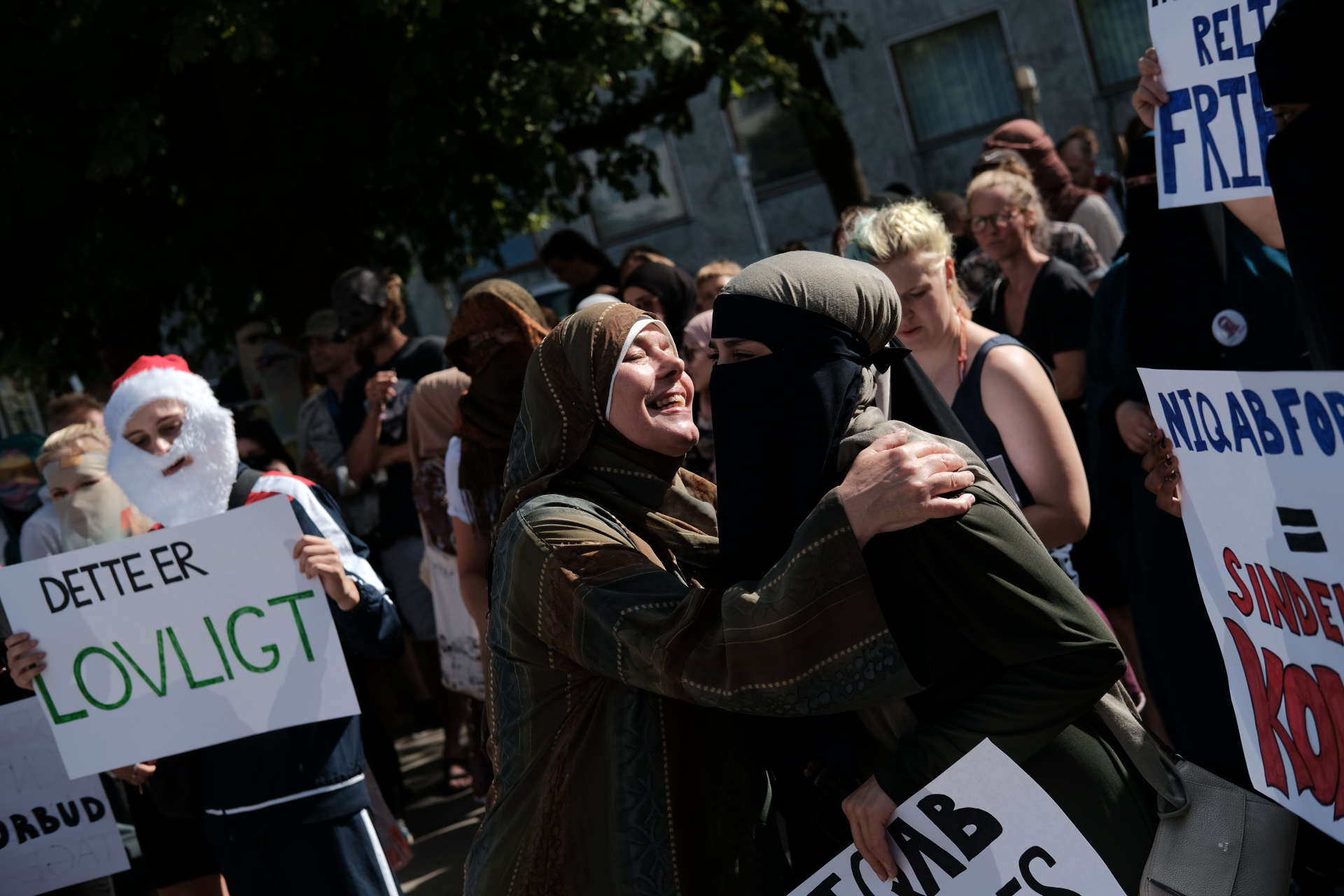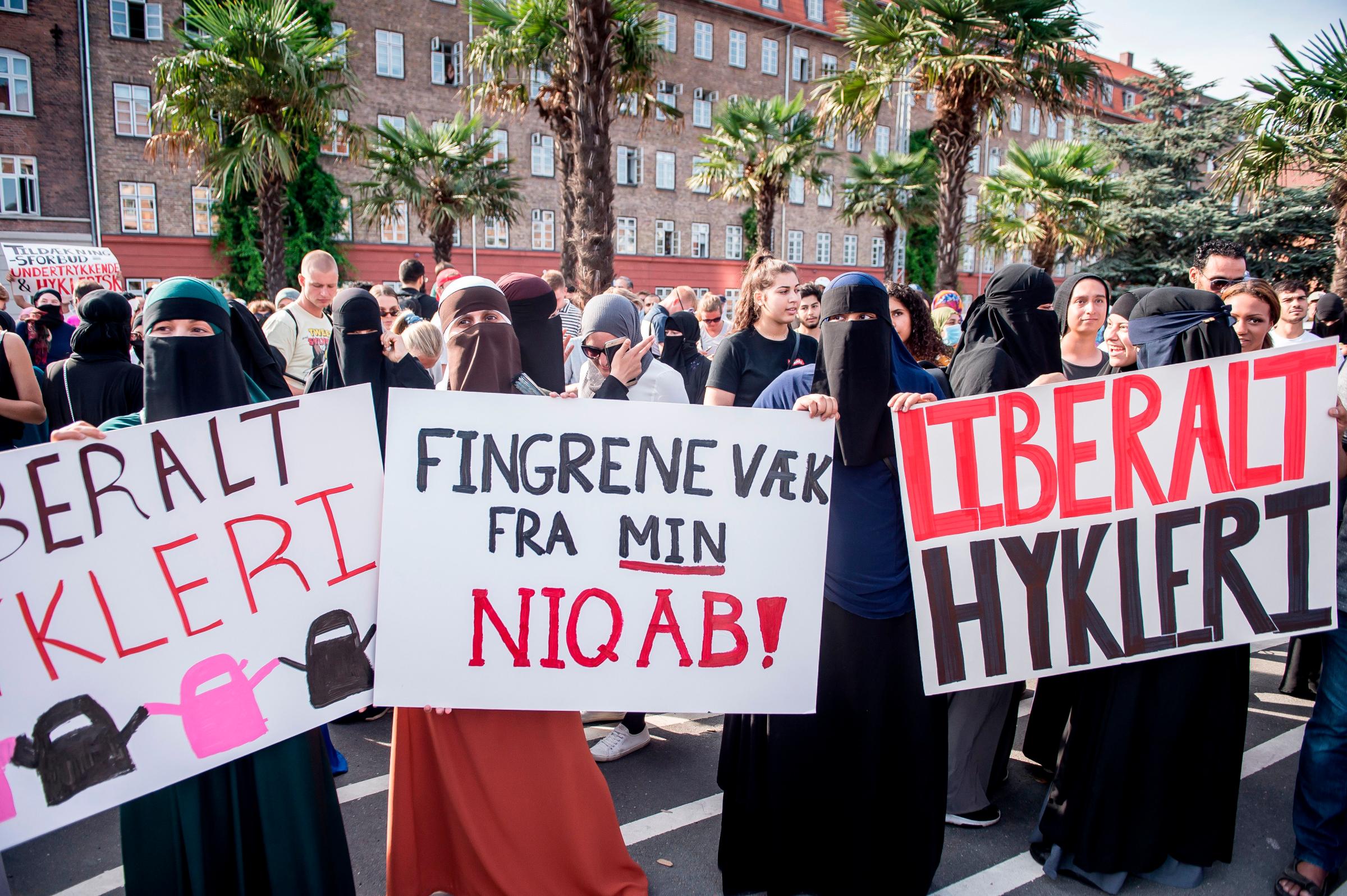Sabina started wearing the niqab two years ago as a way to feel more connected to God. The face veil—a piece of fabric tied around the back of her head that only reveals her eyes—is a reminder of her identity and beliefs, she says. “I found it very beautiful,” the 21-year-old education student explains, sitting cross-legged on the floor of the women’s prayer room in Det Islamiske Trossamfund, a mosque in Copenhagen. “In the beginning it was a very spiritual choice.”
But starting this month when she wears her niqab in public, her act of devotion will also be an act of civil disobedience. She will be one of the Danish citizens defying the country’s ban on face coverings in all public places, which came into effect on Wednesday.
“Now it has also become a political choice for me,” says Sabina, who asked TIME not to disclose her last name out of concerns for her safety. “It is also a sign of protest.”
Sabina is a founder of Kvinder i Dialog (Women in Dialogue), an organization started by niqabis—women who wear the veil—that brings Muslim women affected by the ban into conversation with the larger Danish population through events, social media and public appearances. Their goal has been to dispel what they say are misconceptions about their choice to wear the veil: that niqabis are forced to wear the garment, don’t go to school or work, and are radicalized and pose a threat.
Now their aims have expanded to include standing their ground in Danish society. On the first day of the ban, the women led a public protest over their right to wear the veil. Hundreds of people of different religious and ethnic backgrounds congregated at Den Sorte Plads in Copenhagen’s Nørrebro neighborhood, donning niqabs, colorful scarves and flamboyant face coverings—a horse head, fake beards and lucha libre masks were spotted across the plaza—to challenge the enforcement of the ban. The crowd marched on local streets led by a sign that read “My clothes, my choice” and chanted “No racists in our streets!” as they locked arms around the Bellahøj police station. At the same time, across the country a protest took place in Aarhus, Denmark’s second biggest city.
Many in the crowd said taking to the streets seemed to be the only way to bring attention to the problem. “When I was a kid, no one talked about who you could be and how you could look and dress,” said Line Schmidt, 33, wearing a black balaclava with yellow translucent heart-shaped glasses.“It’s not the Denmark I know.”
To protesters and women who wear the veil, the ban looks like another sign that Denmark is betraying its long-held value of tolerance. “It’s not just about us fighting for the right to wear our niqab,” Sabina says. “It’s also about us fighting for right to live our lives as practicing Muslims in Denmark. We are saying to the government: we do not accept this form of racist, Islamophobic and oppressive politics.”

Denmark’s new law, passed May 31 to take effect from August 1, does not specifically mention the niqab (a veil that covers the face except for the eyes) or burqa (more conservative headwear that covers the head and body and includes a mesh screen over the eyes). It is up to police to judge whether a face covering is in violation of the ban and to instruct the offender to go home. Fines range from 1,000 krone ($156) up to 10,000 krone ($1,568) for repeat offenses.
But many of those in support of the ban have been clear that it is meant to target the Muslim face veil. “We don’t want the burqa and niqab in Denmark,” Naser Khader, a parliament member with the Conservative People’s Party and a Muslim who has long supported the ban, tells TIME. He says it’s about the principle of women not being oppressed, rather than the number of women who wear the veil. “We want gender equality in Denmark, that’s it. If you want to go with burqa and niqab, find another place to do it.”
The current number of women who wear the veil in Denmark is unknown, but the most recent research suggests it is very few. A 2009 study by Margit Warburg, a professor in sociology of religion at the University of Copenhagen, indicates less than 0.2% of Muslim women in the country wear the niqab or burqa—an estimated 150 women out of a country of 5.7 million. “It is really a very small minority out of a minority out of a minority,” says Warburg.
Human rights groups have slammed arguments like Khader’s. While there might be some specific instances where the full-face veil ban might be legitimate in the interests of public safety, Amnesty International argues that the blanket ban is a violation of women’s rights to freedom of expression and religion. “If the intention of this law was to protect women’s rights it fails abjectly. Instead, the law criminalizes women for their choice of clothing—making a mockery of the freedoms Denmark purports to uphold.”
A Continent-Wide Debate
Denmark follows France, Belgium and Austria with full bans on face coverings (Bulgaria, the Netherlands, Germany and other regions and cities across Europe have partial bans based on geographical area or type of space). In 2014 the European Court of Human Rights upheld France’s 2011 law, accepting that social cohesion was a valid argument for the ban, even though fewer than 2,000 women reportedly wore the veil in 2011, out of nearly 5 million Muslims in France.
But enforcement and effectiveness of the ban have been mixed. In Austria, which implemented a similar law in October 2017, police fined people with scarves and a man in a shark costume because of confusion over the vague wording of the law. France, the first European country to introduce such a ban, has consistently enforced the law—but surveys indicate niqabis continue to wear the veil but spend more time indoors (though there is little research on women who wear the veil after the ban).
“It divides society,” says Sara Silvestri, professor of religion and politics at City, University of London, and an expert on Islam in Europe. “It either withdraws women into the closely-knit community or empowers them to fight back and become even more religious and even more proud to wear the veil.”
In Denmark both the center-right government and center-left Social Democrat party voted in favor of the ban, passing the law 75-30. At the heart of the government’s argument were concerns over the subjugation of women and a need to enforce Danish culture and values.“We must be able to see each other and we must also be able to see each other’s facial expressions,” Justice Minister Søren Pape Poulsen said when the ban was passed in May. “It’s a value in Denmark.” A significant portion of the Danish population favored the ban: 62% supported a ban on the niqab and burqa according to an opinion poll from last September.
Denmark is still a homogeneous country: 87.6% of the country’s population is ethnically Danish and 75% of the population is Protestant (based off membership in the state-funded National Church). In recent decades, the country has struggled to integrate immigrants and their new cultures. This year alone, significant debate has raged over policies that seem to target minorities. For example, the country has weighed a citizens’ proposal to outlaw circumcision (mainly practiced by the country’s Jews and Muslims) and the immigration minister suggested Muslims do not work during Ramadan because they pose a safety hazard. And more concretely, the government passed a series of laws to eradicate “ghettos,” neighborhoods with social problems where more than 50% of residents are non-Western immigrants.
“The parliament decides what it means to be Danish,” says Garbi Schmidt, a Roskilde University professor who studies migration and cultural encounters. “Right now, it is Muslims that fall out and minorities that fall out [of that definition]. But it is also problematic for society—how xenophobic should it be when it comes to ethnic, religious and all kinds of diversity? Who has the right to live as a Dane?”

Fighting for the Right to Wear the Veil
Asserting the right to live as a Dane while wearing the niqab has been the goal of Kvinder i Dialog since it officially launched in January. The group, which has grown to approximately 60 niqabis and allies, has hosted open houses, stood on the street handing out flyers, visited high school classrooms and participated in debates on the issue, all in the hopes of trying to help their fellow citizens understand their choice. “We were saying to everyone, just ask us whatever you like,” Sabina says. “Let’s talk about it.”
By becoming more visible, Kvinder i Dialog has been able to change some minds. “If you are forced to wear it, I would not understand why you are fighting so much for it,” Sabina recalls a woman telling her at an open house. But it hasn’t always worked. Politicians have refused to take their meetings and they’ve received hateful responses on their social media posts.
Part of the problem is that many Danes have never seen, let alone met or talked to, a woman who wears the niqab, Sabina says. That fueled misconceptions about the background and motivations of the niqabis. Half of the women that Warburg found in her 2009 study were ethnic Danes, for example, as recent converts tend to be more devout in their religious expression. Further, women wear the niqab as a way to challenge and deepen their faith, Warburg says. She did not find evidence that there were women being forced to wear the veil in Denmark.
Women who choose the niqab say oppression has not come from the veil itself, but from Denmark’s opposition to it. Sarah, a gregarious 30-year-old student, mother of three and another founder of Kvinder i Dialog, said it was already difficult to wear her face covering in public. Once a man threatened to kill her at a train station in front of her then 3-year-old son.
Despite this, Sarah, who was born in Denmark to a Muslim family and speaks Danish as her first language, grew up believing that the country’s tradition of tolerance would protect her religious choices and allow her to follow her dreams of studying engineering and starting her own business. Now Sarah—who asked TIME to only use her first name to protect her privacy—is considering switching to e-learning to finish her courses, and her husband has agreed to take full responsibility of picking up their children from school and running errands.
“If I want to go somewhere, I really have to think about it—is it worth getting a fine?” she says, bouncing her curly-haired 7-month-old daughter on her lap during a preparation workshop for the protest on Wednesday. “I have never felt like a victim before. This is the first time I’ve felt oppressed.”
Still, she sees the veil as a source of power as she begins life after the ban. “You have to be very strong to wear the niqab in Denmark,” Sarah says. “We are not going to lie down and let people kick us. We are going to fight to the end.”
More Must-Reads from TIME
- Donald Trump Is TIME's 2024 Person of the Year
- Why We Chose Trump as Person of the Year
- Is Intermittent Fasting Good or Bad for You?
- The 100 Must-Read Books of 2024
- The 20 Best Christmas TV Episodes
- Column: If Optimism Feels Ridiculous Now, Try Hope
- The Future of Climate Action Is Trade Policy
- Merle Bombardieri Is Helping People Make the Baby Decision
Contact us at letters@time.com